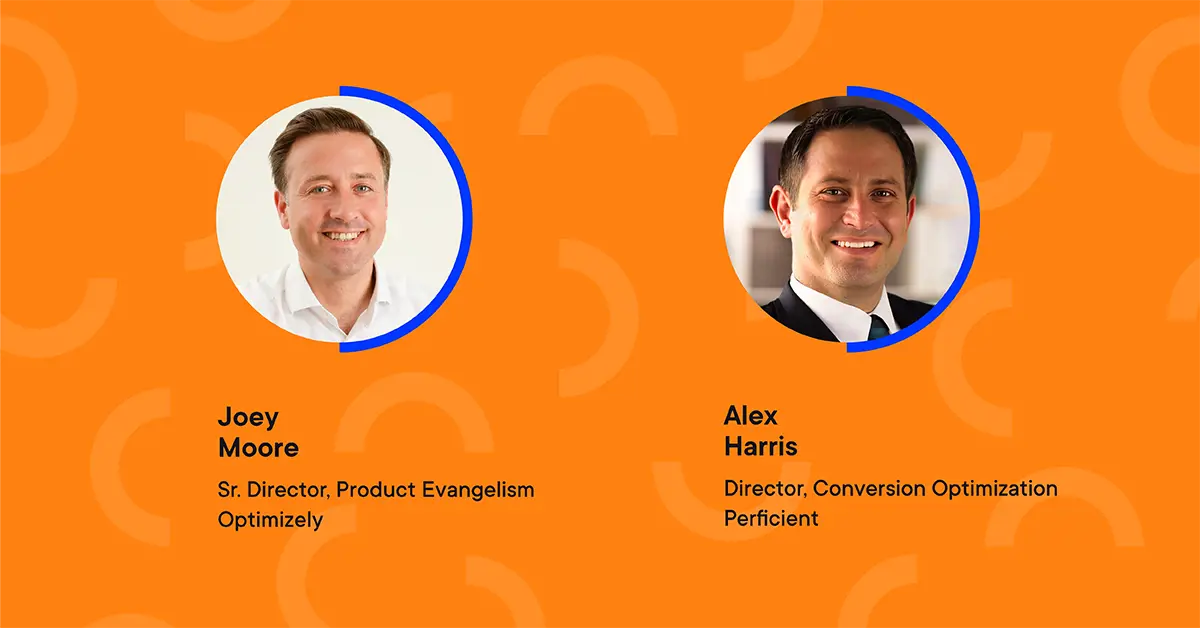Master the shift: 5-step-guide to migrating from Google Optimize
Discover why sunsetting Google Optimize can be the dawn of a new era for your experimentation program. That’s why the team at Perficient has mapped out 5 clear steps to a successful transition.

Joey Moore

Getting ready to say goodbye to Google Optimize? So, check out our recent live Webinar with expert Alex Harris - Optimization Director at Perficient. Alex provided a ton of insightful advice for anyone looking to migrate to a new experimentation platform – and the recording is now ready to view.
In a nutshell, you’ll discover why sunsetting Google Optimize can actually be the dawn of a new era for your experimentation program. That’s why the team at Perficient has mapped out 5 clear steps to a successful transition - and our 30-minute webinar took viewers through them one by one.
“Remember, Google Optimize sunset is not an end. You can make it the start of an incredible opportunity to optimize, innovate, and drive more meaningful results for your business.”
Step 1. Document your Google Optimize history
To get us started, Alex explained why any move to a new tool starts with a state-of-the-nation appraisal of where you are right now - and exactly what kind of information you should be documenting. You should be documenting a/b test results, personalization campaigns, and how you set up all your analytics, events, and audiences in those tools because they can be specific. Even the workflows and culture of experimentation that you deal with, such as troubleshooting documentation. Have all this info in some kind of internal library that you can refer to anytime.
He also emphasized the fact you should be doing this right now even if you aren’t migrating to a new system. Documentation not only allows you to set up a successful pathway for migrating away from Google Optimize. It also allows you to establish baselines for success that you can keep on improving to continue driving growth.
“The sunsetting of Google Optimize opens a really great opportunity to re-evaluate your internal experimentation system, understand your knowledge base, and set your baseline for future growth.”
Step 2. Evaluate Google Optimize alternatives – like Optimizely Web Experimentation
Now you’re out in the market and looking for the right kind of system, you probably already know there’s no shortage of tools out there serving a lot of different use cases, a lot of different-sized organizations, and a lot of different industries. In the next step, Alex took us through a watertight approach to evaluating and selecting your next testing tool.
Price, budget, scale, and capabilities are all obvious considerations. But we also saw how vital it is to factor in flexibility. The flexibility to handle your current use cases. The flexibility to meet the needs of your teams, putting the power in their hands and making them more successful. And the flexibility to scale up and adapt over time.
Consider if the alternative tool:
- Can work within your page rendering and your website overall.
- Is secure enough to be added to your website.
- Is not going to slow down your site.
- Can give collaborators different roles?
- Can integrate with G. A. 4 and another analytics tool.
“It's really aligning skills with the right tool, and then ensuring the tool has enough flexibility to work within those teams and improve the output and the results.”
The key takeaway here was simple: Don't just base your decision on where you are today, but look at your longer-term ambitions for the next six, 12, 24 months so you can futureproof your experimentation program.
Step 3. Implement your experimentation tool to work for all your teams
Once you’re down to a shortlist of vendors, you now need to consider the ease of implementation. After all, these kinds of technical migrations instantly summon up images of long days, late nights, head-scratching, and headaches. For example, Google Optimize was free and that was one of the main reasons many organizations used it. But it wasn’t all that easy to actually implement.
“Google Optimize was simple enough to get onto a website, but once deployed many customers faced a lot of flickering. And many ended up having to put extra code onto their sites to prevent that flicker.”
Alex explained that implementation doesn't have to be a daunting task. You can go out right now and choose a tool that’s as simple to get started as deploying a one-line JavaScript code. But as you’ll hear, the onboarding process extends beyond a purely technical aspect. It should walk through each of the different teams and help them create an individual playbook. You also need to involve your different teams and build in their specific goals such as acquisition, security, features, retention, or lifetime value.
For example, Marketing might be focused on acquisition. It is focused on security and improving its features. The content team might be focused on retention, improving lifetime value, and more. It's ensuring your implementation is set up directly to work with different teams.
Step 4. Accelerate growth through accelerated experimentation
If you want to accelerate your experimentation and drive value across the business, you’re in luck – because that’s exactly what the fourth step looks at. Alex outlined the journey to ratcheting up your program and moving up through the gears from crawling to walking to running.
We heard how and why a lot of organizations have been held back by Google Optimize and some of the other tools they may have been using to date. And how the right experimentation tool is going to empower you to accelerate the velocity of your experiments to the point where you run four or five at the same time. After all, the secret to a successful experimentation program is a strong pipeline of experiments, so when one finishes you always have another one ready to go.
“Accelerated experimentation involves improving your workflow, aligning your collaborative teams, establishing a culture of experimentation, introducing integrations that bring in data from other places like Facebook, Google, or Salesforce, and then creating an experience that delivers that one-to-one personalization.”
Step 5. Build a culture of experimentation
And finally, Alex emphasized the importance of building a true culture of experimentation across your organization. Beyond simply gaining buy-in from leadership, we’re talking about managing an entire cultural transformation and introducing a completely different mindset. The strategy and the team working together should all focus on growth. So, when teams have their OKRs and certain KPIs they need to improve upon, you use the experimentation tool to establish the baseline of each event and then continue to improve upon them.
The idea is to make the most of a culture of experimentation within the business and leverage that across multiple teams and multiple systems, making sure that you’re addressing the objectives and KPIs of the different teams that you're working with.
You’ll hear some great ideas for introducing this experimentation mindset by working collaboratively and creating camaraderie. For example, you can create experiments on different sections of your site. Now, you can accelerate the velocity of experiments within each testing track, so you could have 4 or 5 experiments running at one time. And the goal of a successful experimentation program is to have a backlog experience. So, when one experiment finishes, you always have another one ready. Only then can you make sure you're all on the same page and all focused on the same thing - growth and moving to the next level.
“I was a creative director for a very long time, and as designers, we do have egos. We like to create things that are beautiful. And what I learned very quickly through testing is what’s pretty doesn't always win.”
The beginning, not the end
And that was a wrap. Once you’ve seen this 30-minute webinar, it’s easy to understand why you should be looking at the sunsetting of Google Optimize as an opportunity to accelerate and upscale some of the things that you’ve benefited from in the past – as well as introduce new and powerful tools you’ve been missing until now.
Because when you get the transition right, you’ll find that experimentation offers a single, powerful system that supports the goals of your organization: making more money, increasing revenue, and reducing CPAs.
The webinar is free to view and ready to go right now.
By the way, did you know that Optimizely is the replacement of choice?
We’re recommended by Google and ready to seamlessly integrate with all your Google products. For further info and a limited, one-time-only platform + migration services discount, please visit here.
